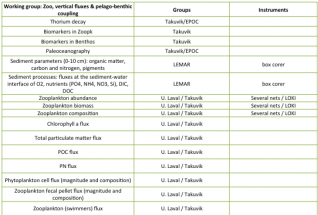Scientific work aboard the CCGS Amundsen
Working group categories for sampling and research interests: Zooplankton, vertical fluxes & pelago-benthic coupling
Most of the time, critters above 150 µm in size are animals (either herbivores of carnivores); they are what we call Zooplankton. In the ocean most of them are copepods. To catch them scientists deploy nets of various mesh sizes either vertically or horizontally.
Just like on land, the bigger the critter, the lower their abundance in a given surface (or volume), so where it is enough to filter 3L of seawater to study phytoplankton, thousands of liters need to be screened to have enough material for zooplankton studies (a vertical net tow of 300m depth with a 0.6m diameter net screens about 80m3 of water). A camera system can be coupled to the nets (LOKI).
While vertical nets allows the total zooplankton biomass to be determined and species to be identified, the vertical distribution is assessed using horizontal towing sequences at various depths.
Zooplankton actively participate in vertical fluxes of carbon (zooplankton poops), as do dying phytoplankton when they sink to the ocean floor. These vertical fluxes are very important for sustaining the organisms living on the sea bed (so-called Benthos), and for the long-term sequestration of carbon.
Usually, vertical carbon fluxes are measured by deploying sediment traps in the water column. These traps can be moored at a given depth or left to float in place for various periods of time. Samples entering the trap fall into a vials containing a preservative. Analyses are done after the traps are recovered between 1 day and 2 years after deployment.
Benthos is sampled using a trawl (Agassiz) towed by the ship. The trawl collects sediment from the ocean floor, bringing to the surface a large variety of critters (sea stars, molluscs, worms etc…). Population is sorted and identified on board.
Sediment is also collected using a box-core. Benthos specialists incubate sediments to measure respiration and production processes in the top layers of the ocean floor mud.




One thought on “Scientific work: Zooplankton, vertical fluxes & pelago-benthic coupling”